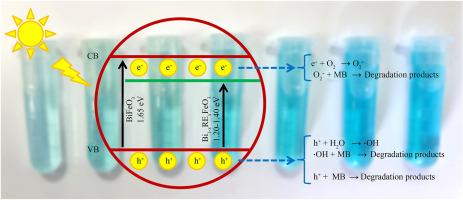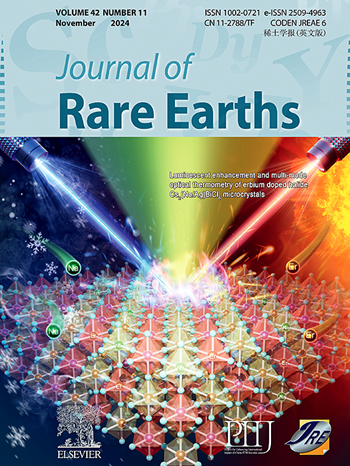Structural, optical, and photocatalytic properties of Bi1–xRExFeO3 (RE=La, Ce, Pr, Nd, Sm; x=0, 0.05, 0.1) thin films
IF 7.2
1区 化学
Q1 CHEMISTRY, APPLIED
引用次数: 0
Abstract
Bismuth ferrite perovskite materials have recently attracted great attention because of their unique properties. In this study, Bi1–xRExFeO3 (RE = La, Ce, Pr, Nd, Sm; x = 0, 0.05, 0.1) thin films were deposited on glass substrates via low-temperature sol–gel assisted spin coating procedure. It is found that in the presence of light rare-earth ions as the substitutions, the structural, morphological, and optical properties of the thin films are changed in the prepared thin films. We find that the thin films have rhombohedral structures, and from field emission scanning electron microscopy (FESEM) images, it is observed that the substitution of light rare-earth ions for Bi3+ affects the surface morphology and grain size of the BiFeO3 (BFO) thin film. Moreover, the optical properties of prepared films were investigated via UV–visible spectroscopy. For all samples, the bandgap energy values are between 1.22 and 1.65 eV. Also, the refractive index and extinction coefficient of samples are about 1.14–1.41 and 0.1–0.6, respectively. Photocatalytic properties of the samples were investigated by measuring the degradation of methylene blue (MB) dye under irradiation of sunlight. We find that the light rare-earth substituted BFO thin films have better photocatalytic activity compared to pure BiFeO3 thin film, the reason can be described as the band gap varied between 1.20 and 1.65 eV for different rare earth ions which directly influences the photocatalytic properties of the investigated samples. It is observed that the prepared thin films can remove between 37.18% and 69.14% of dye after 180 min of irradiation. This study confirms that prepared thin films are a suitable candidate for photocatalytic applications.

Bi1-RE FeO3(RE=La、Ce、Pr、Nd、Sm;x=0、0.05、0.1)薄膜的结构、光学和光催化特性
铋铁氧体钙钛矿材料因其独特的性能近年来备受关注。本研究中Bi1-xRExFeO3 (RE = La, Ce, Pr, Nd, Sm;X = 0,0.05, 0.1)薄膜通过低温溶胶-凝胶辅助自旋镀膜工艺沉积在玻璃基板上。结果表明,在轻稀土离子的取代下,薄膜的结构、形貌和光学性能都发生了变化。我们发现薄膜具有菱形结构,并且从场发射扫描电镜(FESEM)图像中可以观察到轻稀土离子取代Bi3+影响了BiFeO3 (BFO)薄膜的表面形貌和晶粒尺寸。此外,利用紫外-可见光谱对制备的薄膜的光学性能进行了研究。所有样品的带隙能量值在1.22 ~ 1.65 eV之间。样品的折射率为1.14 ~ 1.41,消光系数为0.1 ~ 0.6。通过测定样品在日光照射下对亚甲基蓝(MB)染料的降解情况,研究了样品的光催化性能。我们发现轻质稀土取代的BFO薄膜比纯BiFeO3薄膜具有更好的光催化活性,其原因可以描述为不同稀土离子的带隙在1.20 ~ 1.65 eV之间,直接影响了所研究样品的光催化性能。经180 min辐照后,所制备的薄膜对染料的去除率在37.18% ~ 69.14%之间。该研究证实了制备的薄膜是光催化应用的合适候选者。
本文章由计算机程序翻译,如有差异,请以英文原文为准。
求助全文
约1分钟内获得全文
求助全文
来源期刊

Journal of Rare Earths
化学-应用化学
CiteScore
8.70
自引率
14.30%
发文量
374
审稿时长
1.7 months
期刊介绍:
The Journal of Rare Earths reports studies on the 17 rare earth elements. It is a unique English-language learned journal that publishes works on various aspects of basic theory and applied science in the field of rare earths (RE). The journal accepts original high-quality original research papers and review articles with inventive content, and complete experimental data. It represents high academic standards and new progress in the RE field. Due to the advantage of abundant RE resources of China, the research on RE develops very actively, and papers on the latest progress in this field emerge every year. It is not only an important resource in which technicians publish and obtain their latest research results on RE, but also an important way of reflecting the updated progress in RE research field.
The Journal of Rare Earths covers all research and application of RE rare earths including spectroscopy, luminescence and phosphors, rare earth catalysis, magnetism and magnetic materials, advanced rare earth materials, RE chemistry & hydrometallurgy, RE metallography & pyrometallurgy, RE new materials, RE solid state physics & solid state chemistry, rare earth applications, RE analysis & test, RE geology & ore dressing, etc.
 求助内容:
求助内容: 应助结果提醒方式:
应助结果提醒方式:


